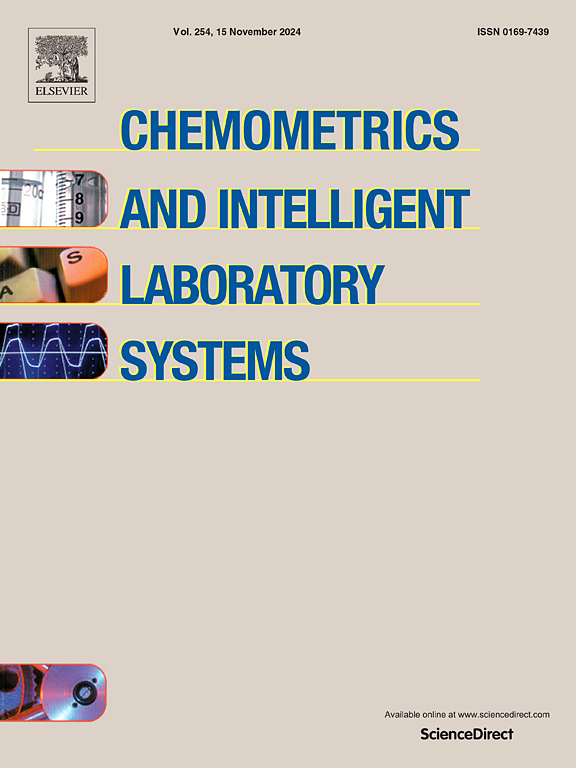Optimization methods for tensor decomposition: A comparison of new algorithms for fitting the CP(CANDECOMP/PARAFAC) model
IF 3.7
2区 化学
Q2 AUTOMATION & CONTROL SYSTEMS
Chemometrics and Intelligent Laboratory Systems
Pub Date : 2024-12-13
DOI:10.1016/j.chemolab.2024.105290
引用次数: 0
Abstract
Tensor decomposition is widely used for multi-way data analysis and computations in chemical science. CP decomposition is one of the most useful tensor decomposition models for capturing the essential information in massive multi-way chemical data and for efficiently performing computations with such tensors. However, efficiently and accurately computing the tensor decomposition itself is a nontrivial problem that sometimes limits the advantage of tensor decomposition methods. In this work we propose and test three new decomposition algorithms, that are defined from extrapolation ideas applied to the alternating least square (ALS) algorithm for CP tensor decomposition. The performance of the proposed algorithms are validated on both a variety of simulated datasets and real experimental datasets including fluorescence spectroscopy data, hyperspectral data and electroencephalogram (EEG) data. The results show that the proposed algorithms significantly accelerate the standard CP-ALS decomposition while maintaining favorable accuracy. One of the proposed methods, denoted direct inversion of the iterative subspace-like extrapolated ALS(CP-AD), is inspired from widely used extrapolation procedures used in the context of solving non-linear equations in quantum chemistry, and shows a particular attractive combination of a much reduced number of iterations needed for convergence, and modest computational cost. For example, CP-AD provided resulting tensors of similar accuracy but significantly lower computational cost than the standard CP-ALS algorithm and the widely used line-search based CP-ALS extrapolation procedure. The proposed methodology may thereby boost the application of tensor decomposition modeling in both experimental and computational chemistry.
张量分解的优化方法:CP(CANDECOMP/PARAFAC)模型拟合新算法的比较
张量分解在化学科学中广泛应用于多路数据分析和计算。CP分解是一种最有用的张量分解模型,它可以从海量的多路化学数据中获取重要信息,并有效地利用这些张量进行计算。然而,有效和准确地计算张量分解本身是一个非平凡的问题,有时会限制张量分解方法的优势。在这项工作中,我们提出并测试了三种新的分解算法,这些算法是从应用于CP张量分解的交替最小二乘(ALS)算法的外推思想中定义的。在各种模拟数据集和真实实验数据集(包括荧光光谱数据、高光谱数据和脑电图数据)上验证了所提出算法的性能。结果表明,该算法在保持较好的精度的同时,显著加快了标准CP-ALS的分解速度。其中一种提出的方法,称为迭代类子空间外推ALS(CP-AD)的直接反演,灵感来自于在求解量子化学非线性方程的背景下广泛使用的外推过程,并且显示出收敛所需的迭代次数大大减少和计算成本适度的特别有吸引力的组合。例如,与标准CP-ALS算法和广泛使用的基于线搜索的CP-ALS外推程序相比,CP-AD提供的结果张量具有相似的精度,但计算成本显著降低。因此,提出的方法可以促进张量分解建模在实验和计算化学中的应用。
本文章由计算机程序翻译,如有差异,请以英文原文为准。
求助全文
约1分钟内获得全文
求助全文
来源期刊
CiteScore
7.50
自引率
7.70%
发文量
169
审稿时长
3.4 months
期刊介绍:
Chemometrics and Intelligent Laboratory Systems publishes original research papers, short communications, reviews, tutorials and Original Software Publications reporting on development of novel statistical, mathematical, or computer techniques in Chemistry and related disciplines.
Chemometrics is the chemical discipline that uses mathematical and statistical methods to design or select optimal procedures and experiments, and to provide maximum chemical information by analysing chemical data.
The journal deals with the following topics:
1) Development of new statistical, mathematical and chemometrical methods for Chemistry and related fields (Environmental Chemistry, Biochemistry, Toxicology, System Biology, -Omics, etc.)
2) Novel applications of chemometrics to all branches of Chemistry and related fields (typical domains of interest are: process data analysis, experimental design, data mining, signal processing, supervised modelling, decision making, robust statistics, mixture analysis, multivariate calibration etc.) Routine applications of established chemometrical techniques will not be considered.
3) Development of new software that provides novel tools or truly advances the use of chemometrical methods.
4) Well characterized data sets to test performance for the new methods and software.
The journal complies with International Committee of Medical Journal Editors'' Uniform requirements for manuscripts.

 求助内容:
求助内容: 应助结果提醒方式:
应助结果提醒方式:


